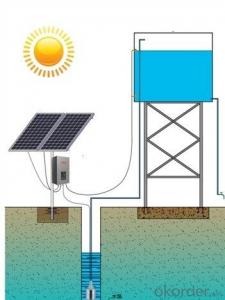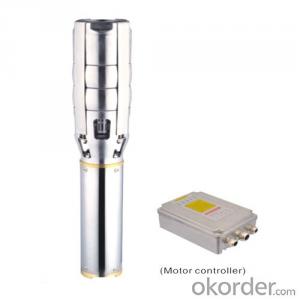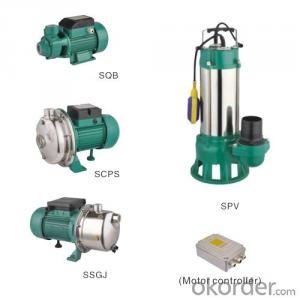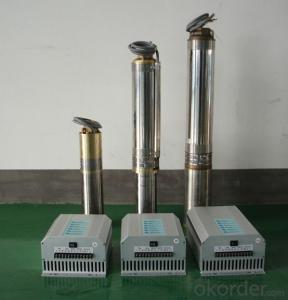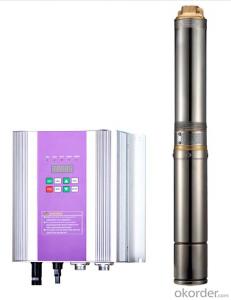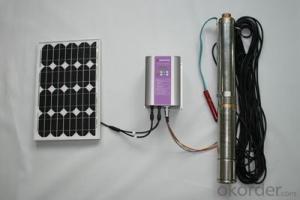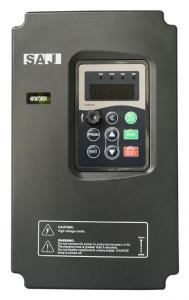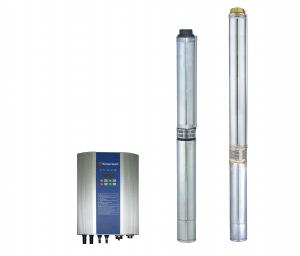Solar Pump 12v DC Solar Powered Water Pump System for Solar Pool Pumps
- Loading Port:
- Shanghai
- Payment Terms:
- TT OR LC
- Min Order Qty:
- 1 set
- Supply Capability:
- 1000 set/month
OKorder Service Pledge
OKorder Financial Service
You Might Also Like
Solar Powered Water Pump System Solar Pool Pumps
DC solar water pumping system consists of the motor, pump, controller, solar array and some other accessories, such as water level sensor, float switch, etc. Considered that storing water is more efficient than storing electricity, the system is designed to directly drive the pump without battery which can reduce the construction and operating cost and routine maintenance effectively.The PV array consists of multiple solar panels connected in series/parallel, which can supply the whole system as power source by converting the absorbed solar radiation energy to the electrical energy. The pump driven by a brushless DC permanent magnet motor draws water from deep-well or river. The pumped water is then fed into reservoir or water tank, or connected to the irrigation system or fountain system directly.
Advanced Technology
Applications Innovation
The efficiency of DC brushless permanent magnet motor has been increased up to 25% in comparison with traditional asynchronous motor.
Technology Innovation
Stator and rotor are sealed by environment friendly casting resin.Motor insulation resistance can be hold higher than 300MΩfor more than 10 years, which consumedly increased the security and reliability of the submersible motor.
Structure Innovation
Casting resign technology processed stator and rotor as well as the water lubricated bearing make the submersible pump environment friendly.
Feature
High Efficiency & High Reliability
DC Brushless Permanent Magnet Motor
Minimum Maintenance, long Service Life
Environment Friendly Materials, Lubricated Without Oil
Application
Village or Family Water Supply
Animal Drinking Water & Livestock Watering
Garden/Courtyard Irrigation
Swimming Pool
Water Supply for Bivouac or Camping Car
Water Supply for Remote Area
Automatic Control
Operate Automatically, No Need Watching
Maximum Power Point Tracking (MPPT)
Dry-run Protection
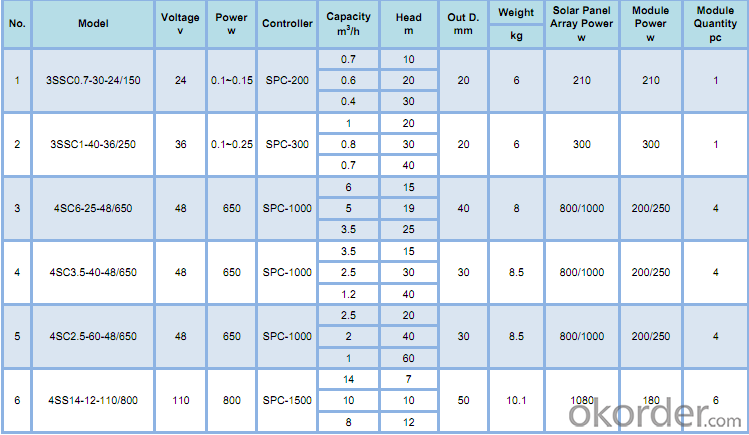
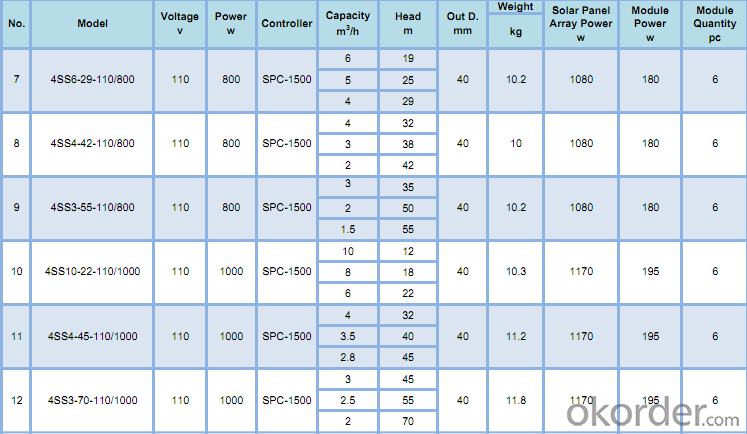
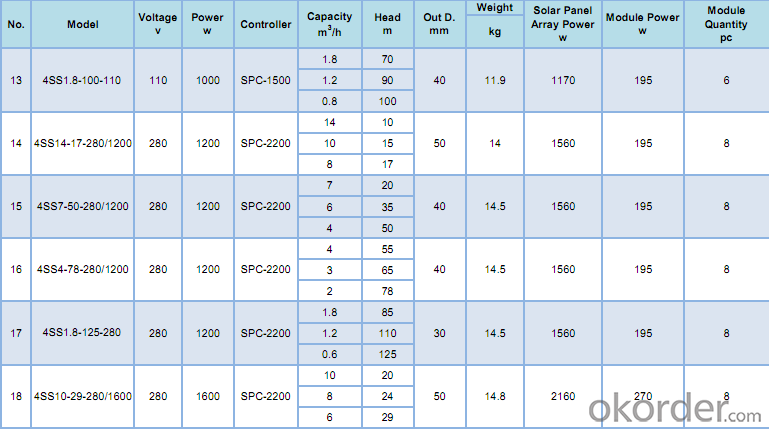
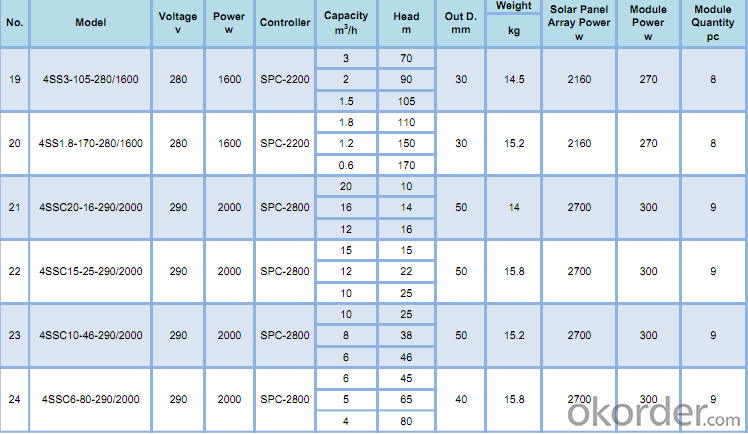

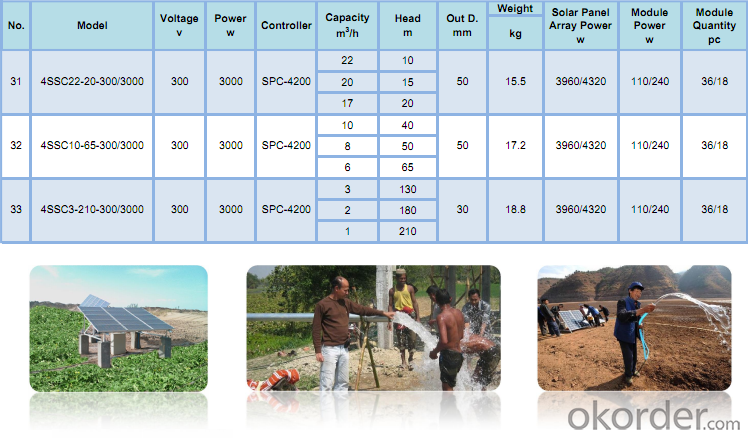
- Q: Can a solar pump be used for water supply in agricultural applications?
- Yes, a solar pump can be used for water supply in agricultural applications. Solar pumps are an efficient and sustainable solution for providing water in remote locations or areas with limited access to electricity. They harness solar energy to power the pump, eliminating the need for grid electricity or fuel. This makes them cost-effective and environmentally friendly options for irrigation, livestock watering, and other agricultural water supply needs.
- Q: Can solar pumps be used for water supply in refugee camps or temporary settlements?
- Yes, solar pumps can be effectively used for water supply in refugee camps or temporary settlements. Solar pumps are an ideal solution as they are environmentally friendly, cost-effective, and can operate in remote areas without access to electricity. They provide a sustainable and reliable source of water for drinking, sanitation, and other essential needs in these temporary settings.
- Q: What is the expected noise level of a solar pump during installation?
- The expected noise level of a solar pump during installation is generally low to minimal. Solar pumps rely on photovoltaic technology to convert sunlight into energy, eliminating the need for noisy mechanical components like engines or motors. This makes the installation process relatively quiet, ensuring a peaceful environment for both the installers and nearby residents.
- Q: How does the size of the water reservoir affect the performance of a solar pump?
- The size of the water reservoir can have an impact on the performance of a solar pump. A larger reservoir allows for more water storage, which can provide a consistent and steady water supply to the pump. This can enhance the pump's efficiency and performance, as it can operate for longer periods without interruption. Additionally, a larger reservoir can help mitigate the effects of fluctuations in solar energy availability, ensuring a more reliable water pumping system overall.
- Q: Can a solar pump be used for water supply in residential communities or housing complexes?
- Yes, a solar pump can definitely be used for water supply in residential communities or housing complexes. Solar pumps are an excellent alternative to traditional electric pumps as they are powered by solar energy, which is clean, renewable, and abundant. These pumps use photovoltaic panels to convert sunlight into electricity, which in turn powers the pump to draw water from a source such as a well, borehole, or reservoir and distribute it to the desired location. There are several advantages of using a solar pump for water supply in residential communities or housing complexes. Firstly, solar pumps are cost-effective in the long run as they do not require any fuel or electricity to operate, resulting in reduced energy bills. Additionally, solar pumps have low maintenance requirements, leading to further cost savings. Furthermore, solar pumps are environmentally friendly as they do not produce any greenhouse gas emissions or contribute to air pollution. They also help conserve water as they can be equipped with sensors and controllers to optimize water usage and prevent wastage. Solar pumps are reliable and efficient, capable of operating even in remote areas with limited access to the electrical grid. They can provide a consistent and uninterrupted water supply throughout the day, ensuring the needs of the residential community or housing complex are met adequately. In conclusion, solar pumps are an excellent choice for water supply in residential communities or housing complexes. They offer numerous benefits such as cost savings, environmental sustainability, and reliable operation. With their ability to harness the power of the sun, solar pumps provide a sustainable and efficient solution for meeting the water demands of residential areas.
- Q: How does the cost of a solar pump compare to a traditional electric pump?
- The cost of a solar pump is typically higher than that of a traditional electric pump, primarily due to the additional cost of solar panels and related equipment. However, the long-term savings in electricity bills and the environmental benefits of solar energy make it a more cost-effective and sustainable option in the long run.
- Q: Can a solar pump be used with a battery backup system?
- Yes, a solar pump can be used with a battery backup system. The battery backup system can store excess solar energy generated during the day and supply it to the pump during periods of low or no sunlight, allowing for continuous operation. This ensures that the pump can still function even when there is insufficient sunlight available.
- Q: Can a solar pump be used for water supply in off-grid botanical gardens?
- Water supply in off-grid botanical gardens can be facilitated by the use of solar pumps. These pumps are an environmentally friendly and sustainable option for remote areas lacking traditional electricity. They function by converting sunlight into electricity through solar panels, which in turn powers the pump to draw water from sources like wells or ponds. Consistent and reliable water supply is crucial for the well-being and growth of plants in botanical gardens. Solar pumps offer an ideal solution for such locations, as they eliminate the need for grid electricity or fuel. Furthermore, they are available in various sizes and capacities to meet the specific requirements of each botanical garden. These pumps can be utilized for irrigation systems, water features, and even to provide drinking water for visitors and animals within the garden. Additionally, solar pumps can be integrated with water storage systems, such as tanks or cisterns, to store water during periods of limited sunlight or high demand. By implementing solar pumps, off-grid botanical gardens can reduce their reliance on fossil fuels and minimize their carbon footprint. Furthermore, they can enjoy the financial benefits of not having to purchase electricity or fuel for traditional pumps. In conclusion, solar pumps offer an efficient and sustainable solution for water supply in off-grid botanical gardens.
- Q: How does a solar pump help in reducing maintenance costs?
- A solar pump helps in reducing maintenance costs as it operates using solar energy, eliminating the need for electricity or fuel. This reduces the dependence on conventional power sources, which often require regular maintenance and incur additional expenses. Solar pumps also have fewer mechanical parts, resulting in lower chances of breakdowns and the need for repairs. Overall, the use of a solar pump significantly decreases maintenance costs, making it a cost-effective and efficient option for various applications.
- Q: How does a solar pump help in reducing the risk of power outages?
- A solar pump helps in reducing the risk of power outages by utilizing solar energy to operate, eliminating the dependence on the traditional power grid. This means that even during power outages or disruptions, the solar pump can continue to function, ensuring a continuous water supply.
Send your message to us
Solar Pump 12v DC Solar Powered Water Pump System for Solar Pool Pumps
- Loading Port:
- Shanghai
- Payment Terms:
- TT OR LC
- Min Order Qty:
- 1 set
- Supply Capability:
- 1000 set/month
OKorder Service Pledge
OKorder Financial Service
Similar products
Hot products
Hot Searches
Related keywords
